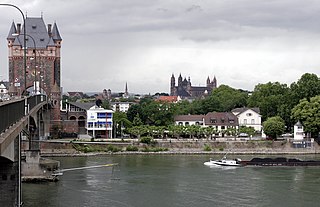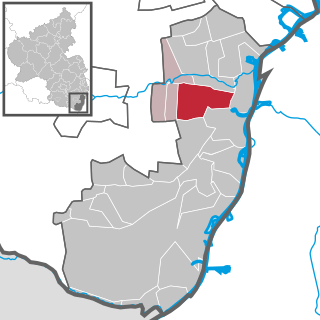
Rhineland-Palatinate is a western state of Germany. It covers 19,846 km2 (7,663 sq mi) and has about 4.05 million residents. It is the ninth largest and sixth most populous of the sixteen states. Mainz is the capital and largest city. Other cities are Ludwigshafen am Rhein, Koblenz, Trier, Kaiserslautern, Worms, and Neuwied. It is bordered by North Rhine-Westphalia, Saarland, Baden-Württemberg and Hesse and by France, Luxembourg and Belgium.

Trier, formerly and traditionally known in English as Trèves and Triers, is a city on the banks of the Moselle in Germany. It lies in a valley between low vine-covered hills of red sandstone in the west of the state of Rhineland-Palatinate, near the border with Luxembourg and within the important Moselle wine region.

Worms is a city in Rhineland-Palatinate, Germany, situated on the Upper Rhine about 60 km (40 mi) south-southwest of Frankfurt am Main. It had about 84,646 inhabitants as of 2022.

The Palatinate, or the Rhenish Palatinate (Rheinpfalz), is a historical region of Germany. The Palatinate occupies most of the southern quarter of the German federal state of Rhineland-Palatinate (Rheinland-Pfalz), covering an area of 2,105 square miles (5,450 km2) with about 1.4 million inhabitants. Its residents are known as Palatines (Pfälzer).

Speyer, historically known in English as Spires, is a city in Rhineland-Palatinate in the western part of the Federal Republic of Germany with approximately 50,000 inhabitants. Located on the left bank of the river Rhine, Speyer lies 25 km south of Ludwigshafen and Mannheim, and 21 km south-west of Heidelberg. Founded by the ancient Romans as an fortified town on the northeast frontiers of their Roman Empire, it is one of Germany's oldest cities. Speyer Cathedral, a number of other churches, and the Altpörtel dominate the Speyer landscape. In the cathedral, beneath the high altar, are the tombs of eight Holy Roman Emperors and German kings.

Neustadt an der Weinstraße is a town in Rhineland-Palatinate, Germany. With 53,300 inhabitants as of 2020, it is the largest town called Neustadt.

Rheinzabern is a small town in the south-east of Rhineland-Palatinate in Germany near the Rhine river. Currently, Rheinzabern, that belongs to the District of Germersheim has approx. 5000 inhabitants living on an area of 12,75 square kilometres.

Forst an der Weinstraße is an Ortsgemeinde – a municipality belonging to a Verbandsgemeinde, a kind of collective municipality – in the Bad Dürkheim district in Rhineland-Palatinate, Germany.

Bellheim is a municipality in the district of Germersheim in the German state of Rhineland-Palatinate. It is situated west of the Rhine, approx. 13 km east of Landau and 15 km northwest of the city of Karlsruhe.

The Rhine-Neckar Metropolitan Region, often referred to as Rhein-Neckar-Triangle, is a polycentric metropolitan region located in south western Germany, between the Frankfurt/Rhine-Main region to the North and the Stuttgart Region to the South-East.

Wachenheim an der Weinstraße is a small town in the Bad Dürkheim district in Rhineland-Palatinate, Germany, roughly 1 km south of Bad Dürkheim and 20 km west of Ludwigshafen. It is known above all else for its various businesses in the field of winegrowing, and in particular for Sekt.

Lingenfeld is a municipality in the district of Germersheim, in Rhineland-Palatinate, Germany. It is situated approximately 5 km north-west of Germersheim, and 10 km south-west of Speyer.

Schifferstadt is a town in the Rhein-Pfalz-Kreis, in Rhineland-Palatinate, Germany. If not including Ludwigshafen, Schifferstadt is the only urban municipality in the Rhein-Pfalz-Kreis.

Niederkirchen is an Ortsgemeinde – a municipality belonging to a Verbandsgemeinde, a kind of collective municipality – in the Bad Dürkheim district in Rhineland-Palatinate, Germany. Its population is roughly 2,400.

Großkarlbach is an Ortsgemeinde – a municipality belonging to a Verbandsgemeinde, a kind of collective municipality – in the Bad Dürkheim district in Rhineland-Palatinate, Germany.

The Schifferstadt–Wörth railway or Speyer line is a uniformly double track and electrified main line in the German state of Rhineland-Palatinate. Between Schifferstadt and Germersheim it is part of the network of the Rhine-Neckar S-Bahn. Between Germersheim and Wörth am Rhein it is part of the network of the Stadtbahn Karlsruhe.

Germersheim station is a junction station in the town of Germersheim in the German state of Rhineland-Palatinate. Deutsche Bahn classifies it as a category 5 station and it has four platform tracks. The station is located in the network of the Karlsruher Verkehrsverbund and belongs to fare zone 575. Since 1996, Germersheim has also been part of the area where the tickets of the Verkehrsverbund Rhein-Neckar are accepted at a transitional rate. The address of the station is Bahnhofstraße 13.

The Rheinische Landesmuseum Trier is an archaeological museum in Trier, Germany. The collection stretches from prehistory through the Roman period, the Middle Ages to the Baroque era with a strong emphasis on the Roman past of Augusta Treverorum, Germany's oldest city. Its collections of (local) Roman sculptures, Roman mosaics and frescos are among the best in Germany.

Geinsheim is a village in the town of Neustadt an der Weinstraße in the Anterior Palatinate in the German state of Rhineland-Palatinate. It was incorporated into the town on 7 June 1969, its parent town lying 10 kilometres to the northwest of Geinsheim.
The history of Speyer begins with the establishment of a Roman camp in 10 BCE, making it one of Germany's oldest cities. Its name evolved from Spira, first mentioned in 614. As of 1294 a Free Imperial City, the town became renowned for its Romanesque cathedral, its vibrant Jewish community, its seat of the Imperial Chamber Court, for 50 diets that took place within its walls, most notably 1526 and 1529, and last but not least, for the Protestation at Speyer. For several centuries from the Middle Ages into the early modern period, Speyer was one of the main centres of gravity of the Holy Roman Empire.























